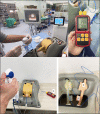Temperature effect of Moses™ 2.0 during flexible ureteroscopy: an in vitro assessment
- PMID: 38230319
- PMCID: PMC10789270
- DOI: 10.5173/ceju.2023.127
Temperature effect of Moses™ 2.0 during flexible ureteroscopy: an in vitro assessment
Abstract
Introduction: One of the main issues related to the use of high-power lasers is the associated rise in temperature. The aim of this study was to characterize temperature variations with activation of the Moses™ 2.0 laser.
Material and methods: An in vitro experimental study was designed using a high-fidelity uretero-nephroscope simulation model to assess changes in temperature during intracorporeal laser lithotripsy. Renal and ureteral temperature records were obtained from the treatment of BegoStones positioned in the renal pelvis. Different laser settings over three time periods and two possible irrigation flow speeds were evaluated. We considered 43°C as the threshold since it is associated with denaturation of proteins. The Wilcoxon-Mann-Whitney test was used to assess quantitative variables and the Kruskal-Wallis test for categorical variables.
Results: The highest increase in intrarenal temperature was reached with 30 seconds of laser activation at a laser setting of 0.5 J/100 Hz (50 W) and a flow of 10 mL/min. Only 15 seconds of activation was sufficient for most settings to exceed 43°C. The ureteral temperature did not increase significantly, regardless of the combination of laser setting, time, or irrigation flow, except when 30 W was used for a 30 second period. Multivariate analysis showed that an irrigation flow of 20 mL/min produced an intrarenal temperature decrease of 4.7-9.2°C (p <0.001).
Conclusions: Use of high-power lasers, both for the ureter and kidney, should involve consideration of temperature increases evidenced in this study, due to the potential biological risk entailed.
Keywords: kidney calculi; laser; retrograde intrarenal surgery; urolitiasis.
Copyright by Polish Urological Association.
Conflict of interest statement
The authors declare no conflicts of interest.
Figures
Similar articles
-
Effect of Laser Settings and Irrigation Rates on Ureteral Temperature During Holmium Laser Lithotripsy, an In Vitro Model.J Endourol. 2018 Jan;32(1):59-63. doi: 10.1089/end.2017.0658. Epub 2017 Nov 15. J Endourol. 2018. PMID: 29048226
-
Thermal effects of Ho:YAG laser lithotripsy during retrograde intrarenal surgery and percutaneous nephrolithotomy in an ex vivo porcine kidney model.World J Urol. 2020 Mar;38(3):753-760. doi: 10.1007/s00345-019-02808-5. Epub 2019 May 16. World J Urol. 2020. PMID: 31098657
-
Holmium:Yttrium-Aluminum-Garnet Laser Pulse Type Affects Irrigation Temperatures in a Benchtop Ureteral Model.J Endourol. 2019 Nov;33(11):896-901. doi: 10.1089/end.2019.0496. Epub 2019 Sep 25. J Endourol. 2019. PMID: 31418291
-
The heat is on: the impact of excessive temperature increments on complications of laser treatment for ureteral and renal stones.World J Urol. 2023 Dec;41(12):3853-3865. doi: 10.1007/s00345-023-04652-0. Epub 2023 Nov 27. World J Urol. 2023. PMID: 38010538 Free PMC article. Review.
-
A Practical Guide for Intra-Renal Temperature and Pressure Management during Rirs: What Is the Evidence Telling Us.J Clin Med. 2022 Jun 15;11(12):3429. doi: 10.3390/jcm11123429. J Clin Med. 2022. PMID: 35743499 Free PMC article. Review.
Cited by
-
The effect of isothermic irrigation fluid on ureteroscopic lithotripsy outcomes.Cent European J Urol. 2024;77(4):674-679. doi: 10.5173/ceju.2024.0053.R2. Epub 2024 Dec 27. Cent European J Urol. 2024. PMID: 40313706 Free PMC article.
-
Rise in intraluminal temperature during ureteroscopy: Is this a concern?Investig Clin Urol. 2025 Jan;66(1):1-10. doi: 10.4111/icu.20240369. Investig Clin Urol. 2025. PMID: 39791579 Free PMC article. Review.
-
Renal and ureteral temperatures changes during ureteroscopic pulsed thulium: YAG laser lithotripsy: an in vitro analysis.Cent European J Urol. 2025;78(1):70-76. doi: 10.5173/ceju.2024.0177. Epub 2025 Feb 28. Cent European J Urol. 2025. PMID: 40371424 Free PMC article.
References
-
- Tsaturyan A, Lattarulo M, Adamou C, et al. . The use of ureteral access sheath during mini-percutaneous nephrolithotomy with high-power holmium YAG laser. World J Urol. 2022; 40: 789-794. - PubMed
-
- Caffaratti J, Villavicencio H. Mini-percutaneous nephrolithotomy with high-power holmium YAG laser in pediatric patients with staghorn and complex calculi. J Pediatr Urol. 2016; 12: 253-255. - PubMed
-
- El-Nahas AR, Elshal AM, El-Tabey NA, et al. . Percutaneous nephrolithotomy for staghorn stones: a randomised trial comparing high-power holmium laser versus ultrasonic lithotripsy. BJU Int. 2016; 118: 307-312. - PubMed
-
- Patil A, Sharma R, Shah D, et al. . A prospective comparative study of mini-PCNL using Trilogy™ or thulium fibre laser with suction. World J Urol. 2022; 40: 539-543. - PubMed
-
- Patil A, Reddy M NK, Shah D, et al. . Holmium with MOSES technology or Thulium Fiber Laser in Miniperc with suction - A new curiosity. J Endourol. 2022; 36: 1348-1354. - PubMed
LinkOut - more resources
Full Text Sources


